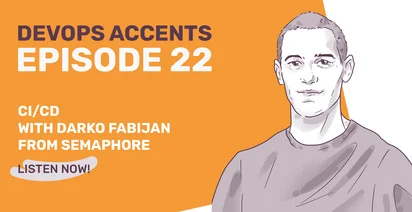CI/CD with Darko Fabijan from Semaphore |🎙️#22

In this episode of DevOps Accents, Pablo and Leo talk to Darko Fabijan, CTO and co-founder of Semaphore, a CI/CD tool for high-performance engineering teams.
- How was Semaphore created?
- How do you go from consulting to supporting a technical tool?
- Why do we still need to convince people that CI/CD is a necessity?
- What is Semaphore's customer base?
- What is CI and what is CD?
- Feedback Loop in DevOps;
- Canary deployment;
- What is the future of CI/CD pipeline?
You can listen to episode 22 of DevOps Accents on Spotify, or right now:
In the realm of software development and operations, the evolution of CI/CD (Continuous Integration/Continuous Delivery) practices marks a pivotal transition towards more efficient, reliable, and faster software deployment processes. A recent discussion with Darko Fabijan, the co-founder and CTO of Semaphore, sheds light on the inception, challenges, and the transformative impact of CI/CD tools on the software development lifecycle. This episode explores the journey of Semaphore, insights into the current state of DevOps, and anticipates the future trajectory of CI/CD technologies.
The Genesis of Semaphore: Bridging the DevOps Divide
Darko Fabijan and his team embarked on their venture into the DevOps arena by identifying a crucial gap in the software development process — the need for a seamless, efficient CI/CD tool. Originating from a background in Ruby and Rails, and transitioning from hardware to software, they recognized the limitations and challenges posed by existing tools like Jenkins. Their quest was motivated by a desire to enhance developer experience, emphasizing user-friendliness and efficiency, mirroring the ease of use found in platforms like GitHub and Heroku.
The Evolution of CI/CD: From Jenkins to Semaphore
Semaphore's journey highlights a transition from reliance on cumbersome, manual integration and delivery processes to the adoption of automated, streamlined CI/CD pipelines. The initial challenges of setting up Jenkins — from its slow performance to the cumbersome upgrade and maintenance process — underscored the need for a tool that could cater to the dynamic requirements of modern software development, especially for Ruby on Rails projects. This led to the creation of a CI/CD tool that not only simplified the setup process but also offered scalability and ease of use, ensuring developers could focus on coding rather than infrastructure management.
The Future of CI/CD: Simplification and Automation
Looking ahead, the future of CI/CD lies in simplification and further automation. As DevOps practices evolve, there's a clear trend towards making these tools more accessible to a broader range of developers, including those newly entering the field. The complexity of current DevOps toolchains can be daunting. The goal moving forward is to create more intuitive, user-friendly platforms that reduce the learning curve and enable developers to implement CI/CD practices more efficiently. This includes integrating AI and machine learning to automate testing and deployment processes further, potentially transforming how developers interact with CI/CD tools.
Continuous Learning and Adaptation in DevOps
The conversation with Darko Fabijan also touches on the broader implications of adopting CI/CD practices, highlighting the ongoing need for developers and companies to continuously learn and adapt. The shift towards CI/CD necessitates a cultural change within organizations, moving away from traditional development practices towards more agile, iterative approaches. This transition is not without its challenges, as it requires not only technical adjustments but also a shift in mindset among developers and operational teams.
Conclusion
The insights from Darko Fabijan and the journey of Semaphore underscore the transformative impact of CI/CD tools on software development and deployment. As we look to the future, the emphasis on simplification, automation, and continuous adaptation will be key drivers in shaping the next generation of DevOps practices. For developers and companies alike, embracing these changes will be crucial in staying competitive and delivering software efficiently and effectively in an increasingly fast-paced digital world.
Show Notes:
Podcast editing: Mila Jones, milajonesproduction@gmail.com
